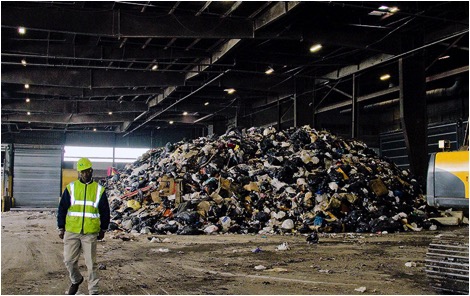
As the most populous city in the United States of America and one of the largest cities in the world, it comes as no surprise that New York City produces a mind-blowing amount of garbage. In fact, it’s estimated that NYC residents and businesses produce more than 20,000 tons of solid waste every single day. This poses the question: how is such a large quantity of waste properly disposed of? Unfortunately, while there have been some strides, the New York City area- and Greenpoint especially- still haven’t quite figured this out.
A study found that NYC businesses produce an approximately 5.5 million tons of waste per year. Shockingly, of those 5.5 million tons, almost 5 million are sent to out-of-state landfills or incinerated rather than recycled. Thus, although Mayor Bloomberg’s 2011 PLaNYC report proclaimed that 40% of the city’s offices, restaurants, stores, hotels, and hospitals recycled, it is estimated that the actual percentage is closer to a meager 24%. Furthermore, annual reports from New York’s Department of Environmental Conservation show that two of the biggest private waste haulers in the NYC area recycled only about 10% of their trash in the past year.
Here in North Brooklyn, however, the problem is on an entirely different level. According to the City of New York Department of Sanitation tonnage reports from the first quarter of 2015, Brooklyn possesses 20 waste transfer stations which handle around 10,551 tons of waste each and every day. Greenpoint and Williamsburg alone have 15 transfer stations, which handle between 30 and 40 percent of the waste generated across all five boroughs. This is astonishingly disproportionate. Out of the whole NYC area, the small areas of Greenpoint and Williamsburg process nearly half of the entire city’s generated garbage, causing a putrid odor that is especially pronounced during the summer days.

This clear over-allocation of waste transfer stations to Greenpoint brings a whole new host of issues to the neighborhood. First and foremost, the constant garbage truck traffic brings with it diminished air quality, which is an issue that Williamsburg and Greenpoint residents have been raising for two decades. In 2009, community volunteers monitored air quality at three different Greenpoint intersections with heavy truck traffic and found that particulate counts jumped an astonishing 355% during weekdays in which truck traffic was present. Compounding the problem is the ceaseless traffic that occurs around transfer stations. A recent study suggested that garbage trucks make up nearly 40 percent of all truck traffic at certain North Brooklyn intersections, several of which are located near schools and houses.
Essentially, it’s painfully obvious that Greenpoint- and New York City as a whole – possesses an inefficient, environmentally-harmful, and unbalanced garbage disposal system. So, what is being done about this?

Mayor de Blasio recently announced a sweeping plan to have the city completely stop sending waste to landfills by 2030. De Blasio cited the fact that New York City simply does not recycle enough of the 44 million pounds of waste that it produces daily. This comprehensive plan would be a massive step in the right direction for New York’s “greenness,” as the amount of trash that the city collectively generates exerts tremendous pressure on the environment.
Instead of waiting for this plan to come in effect, the Greenpoint community is fighting on two fronts: environmental activism and legislative action. With regards to legislation, North Brooklyn Council members Steve Levin and Antonio Reynoso have introduced Intro 495, a measure that would place a limit on the amount of waste processed by any single community district. This legislation would reduce the volume of garbage handled by the most overburdened areas of the city, including Greenpoint and Williamsburg. Proposed in 2014, Intro 495 specifically addresses the fact that two areas of the city, North Brooklyn (Williamsburg and Greenpoint) and the South Bronx, contain over half of the NYC’s waste transfer stations. Intro 495 is still being pushed by North Brooklyn officials, but progress appears to be slow.
On the environmental activism side, local organizations such as Curb Your Litter: Greenpoint are making a significant difference in making Greenpoint a cleaner place to live in. Curb Your Litter: Greenpoint works to get to the root causes of the area’s trash and litter problem and then puts together a plan to directly address these causes. For example, in response to the litter problem in many of Greenpoint’s parks and streets, the organization has partnered with Neighbors Allied for Good Growth (NAG) to create 12 Neighborhood Clean Up Days that provide Greenpointers with a meeting place and a team to clear a specific area of litter and trash. Head over to their website to learn more about how you can personally get involved in their wonderful work. In addition, NAG formed to fight an illegally run waste transfer station on the river and successfully got them kicked out. Bravo to them! In its place, we now have the East River State Park.
If New York City wants to overcome it’s trash problem, it is clear that citizens must come together at the grassroots level and work together towards a greener, more sustainable future. To learn how to get involved and help clean the trash problem in Greenpoint and the greater NYC area, visit the following additional resources:



